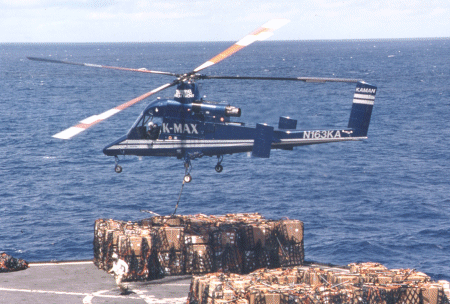
The US Marine Corps has awarded Kaman Aerospace a $4.2 million contract to modify and demonstrate a remotely piloted version of the K-MAX helicopter to further validate its Broad Area Unmanned Responsive Resupply Operations (BURRO) concept.
Flight testing of the unmanned helicopter is to begin around August next year at the USMC's Twentynine Palms base in California, and will last two weeks. The helicopter will be required to lift four 227kg (500lb) underslung loads and perform autonomous drop-offs at different dispersed waypoints using the global positioning system as a reference.
Kaman will fit the cockpit of its K-Max prototype with a remotely piloted control system similar to that developed for the Bell QH-1 unmanned helicopter.
A manned K-Max has completed the USMC Urban Warrior exercise during which it performed BURRO resupply missions. The intermediary-rotor helicopter also lifted the Marine Corps' prototype 2,700kg Dragon Fire autonomous mortar system. It was equipped with the Dragon Drone laser/video designator to provide targeting information.
The Marine Warfighting Laboratory wants to use the K-Max as a BURRO proof-of-concept demonstrator before embarking on possible full-scale development of an unmanned air vehicle. The intent is to operate from high-speed ships and move supplies ashore to support small marine deployments.
Meanwhile, Kaman is understood to be one of three companies to bid for the US Navy's first long-term vertical replenishment (vertrep) contract. Kaman has proposed a pair of commercially operated K-Max machines, while Evergreen is offering two Bell 214STs and AgRotors two Eurocopter Super Pumas.
The contract, due to be awarded in September, will extend for three years beginning from early 2000, with a two-year option. It calls for each helicopter to operate 20h a month and lift a minimum of 2,500kg underslung loads between Military Sealift Command ships and warships operating in the Mediterranean. A second contract is expected to follow to support the US Navy's Pacific fleet.
Source: Flight International























